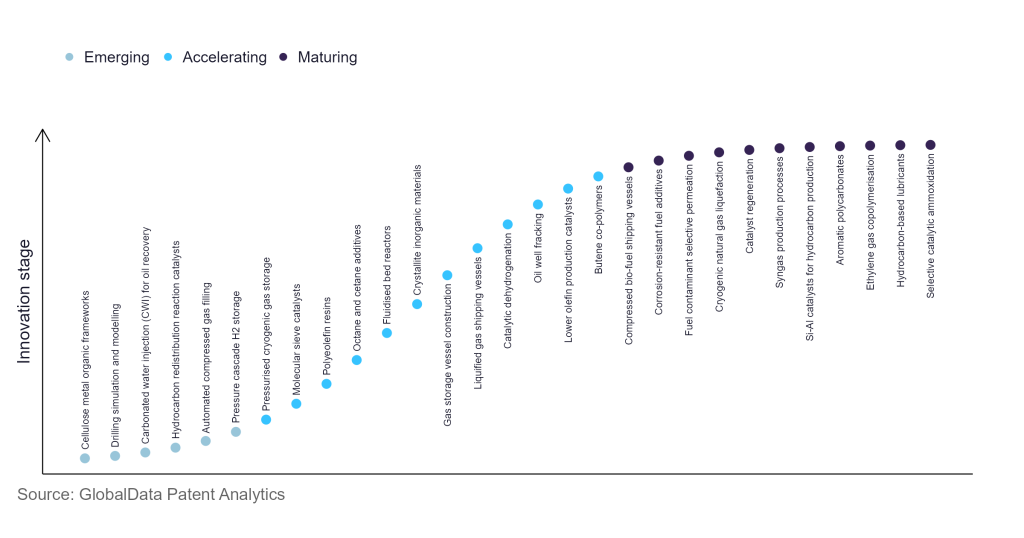The oil and gas industry continues to be a hotbed of innovation, with activity driven by an increasing need for long-term sustainability, reducing capital and operating expenses and cutting its carbon footprint. This is characterised by the growing importance of technologies, such as low-carbon hydrogen, renewable fuels, and carbon capture and storage (CCS). In the last three years alone, there have been over 534,000 patents filed and granted in the oil and gas industry, according to GlobalData’s report on Innovation in Oil & Gas: Liquified gas shipping vessels. Buy the report here.

Discover B2B Marketing That Performs
Combine business intelligence and editorial excellence to reach engaged professionals across 36 leading media platforms.
However, not all innovations are equal and nor do they follow a constant upward trend. Instead, their evolution takes the form of an S-shaped curve that reflects their typical lifecycle from early emergence to accelerating adoption, before finally stabilising and reaching maturity.
Identifying where a particular innovation is on this journey, especially those that are in the emerging and accelerating stages, is essential for understanding their current level of adoption and the likely future trajectory and impact they will have.
40+ innovations will shape the oil & gas industry
According to GlobalData’s Technology Foresights, which plots the S-curve for the oil and gas industry using innovation intensity models built on over 256,000 patents, there are 40+ innovation areas that will shape the future of the industry.
Within the emerging innovation stage, drilling simulation and modelling, carbonated water injection (CWI) for oil recovery, and automated compressed gas filling are disruptive technologies that are in the early stages of application and should be tracked closely. Liquified gas shipping vessels and oil well fracking are some of the accelerating innovation areas, where adoption has been steadily increasing. Among maturing innovation areas are compressed bio-fuel shipping vessels and cryogenic natural gas liquefaction, which are now well established in the industry.
Innovation S-curve for the oil & gas industry

Liquified gas shipping vessels is a key innovation area in oil and gas
A liquified gas shipping vessel is a tanker designed for transporting a liquified gas. These specialised vessels contain multiple tanks, which are heavily insulated for transporting liquified gases at desired pressure and/or temperatures. Liquified gas shipping vessels are designed either with integral tanks, wherein the tank itself is a part of the hull; or independent tanks in which the tank is separate from the ship’s hull.
GlobalData’s analysis also uncovers the companies at the forefront of each innovation area and assesses the potential reach and impact of their patenting activity across different applications and geographies. According to GlobalData, there are 20+ companies, spanning technology vendors, established oil & gas companies, and up-and-coming start-ups engaged in the development and application of liquified gas shipping vessels.
Key players in liquified gas shipping vessels – a disruptive innovation in the oil and gas industry
‘Application diversity’ measures the number of different applications identified for each relevant patent and broadly splits companies into either ‘niche’ or ‘diversified’ innovators.
‘Geographic reach’ refers to the number of different countries each relevant patent is registered in and reflects the breadth of geographic application intended, ranging from ‘global’ to ‘local’.
Hyundai Heavy Industries (HHI), Samsung Heavy Industries, and Kawasaki Heavy Industries are some of the leading companies involved in technology development for liquified gas storage vessels based on their patent filings.
HHI is a leading shipbuilding company that constructs varied types of vessels for transporting liquified natural gas (LNG) and liquified petroleum gas (LPG) carrier vessels, among others.
Samsung Heavy Industries, another prominent shipbuilder, offers vessels for the transport of several liquified gases, including LNG and ethanol. The company leverages its technical expertise to design specialised vessels, such as fuel-efficient LNG carriers and electric-powered LNG carriers.
Kawasaki’s Marine portfolio includes tankers designed for transporting liquified gases, such as LNG, and LPG, among others.
To further understand the key themes and technologies disrupting the oil & gas industry, access GlobalData’s latest thematic research report on Top 20 Oil & Gas Themes 2022.
Data Insights
From

The gold standard of business intelligence.
Blending expert knowledge with cutting-edge technology, GlobalData’s unrivalled proprietary data will enable you to decode what’s happening in your market. You can make better informed decisions and gain a future-proof advantage over your competitors.




